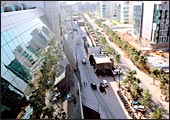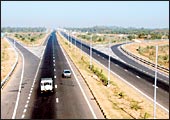 |
| City of contrast: Spread over 1.75 sq.
km, Mumbai's Dharavi is Asia's largest slum, where thousands
of people live |
Scene 1: Bangalore, Silk Board Junction, morning rush hour.
Cars and motorbikes snake endlessly along the narrow road that
leads to the heart of India's Silicon Valley, the Electronic City.
From the junction, it is less than 10 kilometres to the campuses
of India's best-known it companies, Infosys and Wipro, but the
motorists this morning-most of them employed in the booming it
industry-will take anywhere between one and two hours to reach
their workplace. The irony: The junction did get a new flyover
recently, but nobody bothered to widen the road down the stretch.
It is worse on the way back home, because there's no flyover on
this side. Elsewhere in the city, getting stuck on the Airport
road could mean a missed flight.
Scene 2: Mumbai, early July: It has been raining for four
days and life in the city has come to a halt. Places such as Andheri,
Khar, Malad and Bandra-Kurla Complex are waterlogged, suburban
trains are stranded at several places, and there are reports of
rain-related deaths. It's not the first time rains have brought
Mumbai to a standstill. They did too last year and claimed more
than a thousand lives. Weary Mumbaikars are outraged.
Scene 3: Delhi, Seelampur slums: Crumbling brick-and-mud
houses line the sides of a narrow lane, with open drains running
alongside. There are small heaps of garbage all along, smell of
which mixes with that of excreta in the open drains to produce
an overwhelming odour. But unmindful of the surroundings, children
chase each other around and men sit around on charpoys, smoking
beedis and hookahs. Living in these slums means cooking, eating,
sleeping and washing in barely 10x6 rooms. But guess what? That's
how half of Delhi lives.
| THE TOP 10 CITIES |
| 1 |
MUMBAI |
| 2 |
BANGALORE |
| 3 |
DELHI |
| 4 |
CHENNAI |
| 5 |
HYDERABAD |
| 6 |
KOLKATA |
| 7 |
PUNE |
| 8 |
AHMEDABAD |
| 9 |
MYSORE |
| 10 |
VIZAG |
This is not how
best cities are supposed to be. Best cities aren't supposed to
erupt in violence if an ageing movie star dies at the grand age
of 77, like Bangalore did when Rajkumar died on April 12. Neither
are best cities supposed to let walk-in bombers massacre home-bound
rail commuters like Mumbai allowed on July 11, when more than
200 people died. Best cities are supposed to be places where all
their inhabitants can find material and spiritual fulfilment.
The fact that none of India's cities is so, drives home a grim
fact about our fifth Best Cities for Business survey: These are
best of the worst cities. Power cuts, water scarcity, congested
roads, pollution, dirt and roadside squalor are par for the course
at almost all Indian cities.
Yet, it is these overcrowded and crumbling
cities that drive India and make it the second-fastest growing
economy in the world. Cities and towns are where 30 per cent of
our people live, with 38 per cent of the urban population confined
to just the top 35 cities. Fifty-five per cent of the country's
GDP emanates from urban India; 50 per cent of the foreign direct
investment goes to the seven largest cities. Globally, cities
are the engines of their economies. They are too in India.
But the stress on our cities has begun to
tell. As India's population and economy grew, more and more people
migrated to the cities in search of a livelihood. But the cities
themselves never planned to keep pace with their growth. There
was no urban planning to talk of, resulting in haphazard development.
Poor zoning compliance turned residential localities into commercial
centres, and slums came up wherever they could. Today, 22 per
cent of the city dwellers live in slums, and half of them work
in the informal economy as hawkers, mechanics or roadside vendors.
"A city is not just a place of employment, but a place of
hope," notes Kavas Kapadia, Professor & Head of Urban
Planning at Delhi's School of Planning and Architecture (SPA).
 |
| Hi-tech Hyderabad:
One of the more progressive cities, it ranks high in
availability of office space and housing facilities |
Why have we neglected our cities, then? Because
our early political leaders always thought of India as an agrarian
country. Therefore, urban development, a state subject, was never
accorded priority and all the five-year plans allocated token
sums to cities for development. The Mega City Scheme of 1993-94,
for instance, allocated Rs 75 crore to five mega cities for a
five-year period, meaning Rs 15 crore a year. "You can't
build half a flyover with that sort of money," quips Vijay
Dhar, hudco Chair Professor at the National Institute of Urban
Affairs. Property tax is supposed to be the single-biggest source
of revenue for city municipalities, fetching three-fourths of
all revenue collections in cities that don't have octroi. But
thanks to poor compliance, outdated property valuation systems
and leakages, India's cities and towns (more than 5,000 of them)
collect just Rs 12,000 crore a year. Obviously, bigger cities
such as Delhi and Mumbai account for the lion's share of this
money. "If you don't remove regulatory constraints and rebalance
the power equation between the Central government and the states
on the one hand and between the states and their cities on the
other, infrastructure in cities can't be developed," says
Om Prakash Mathur, Professor, National Institute of Public Finance
and Policy (NIPFP).
A large part (70 per cent) of India still
lives in villages, but not quite the way it used to. Agriculture's
contribution to the GDP is shrinking. Between 1990 and 1995, it
accounted for a third of GDP. Today, its share is a little more
than a fifth. More importantly, it has finally sunk into our policy
makers that neglecting our cities is a lose-lose game. When choked
drains bring Mumbai to a halt, there's real business and productivity
loss in India's financial capital. When Bangalore riots and tech
workers aren't able to reach their workplace, companies lose real
export dollars. In other words, when our cities lose, India loses.
"Compared to some other cities in the world, we are 180 years
behind in city management and, therefore, have to fight 180 times
harder to come up," says SPA's Kapadia.
 |
| The IT boom: The
outsourcing wave has bettered lives for many, but millions
more have been left untouched |
A Plan To Save Our Cities
Thankfully, an ambitious urban renewal plan
has been put in place. Last year in December, Prime Minister Manmohan
Singh announced the setting up of the Jawaharlal Nehru National
Urban Renewal Mission (JNNURM). It draws a lot from the Urban
Reform Incentive Fund announced in the 2002-03 budget by the then
Finance Minister, Yashwant Sinha, but it differs in two key aspects:
Compared to the Rs 500 crore that Sinha allocated to the fund,
JNNURM boasts a staggering Rs 50,000 crore against matching contributions
by recipient cities. More importantly, it makes it mandatory for
cities to get their governance and accountability in place before
laying their hands on the fund. "In the scale of its ambition
and the nature of its rigour, JNNURM has no parallel," says
Ramesh Ramanathan, National Technical Advisor to the mission.
He isn't exaggerating. It's for the first
time that India has started on a concerted effort to renew its
urban centres. Unlike in the past, money isn't to be allocated
and spent in dribbles and drabs. To start with, the mission has
identified 63 cities, based on criteria such as the size of population
and tourism potential, for development. An estimated Rs 1,20,536
crore is required to develop these cities, half of which will
come from the Central government. The matching rest must be raised
by the cities themselves. Since JNNURM has sweeping goals, it
is easier to mention what sort of projects don't qualify for assistance.
These relate to power, telecom, health, education, wage employment
and employment creation. Everything else-widening of city roads,
improving water supply and sanitation, and even relocation of
slums-is admissible for assistance.
 |
| Urban champ: Union Secy Baijal is driving
JNNURM |
The mission money won't come free. Since governance
and accountability have been the reasons why our cities never
kept pace with growth, there is a string of mandatory and optional
reforms at the level of urban local bodies (ULBs) and states.
For instance, it is mandatory for the beneficiary municipality
to adopt modern, accrual-based, double-entry system of accounting
so that a city's profits and losses are clearly visible to its
citizens. It is also mandatory for it to introduce e-governance,
using software such as GIS (geographic information system) and
MIS (management information system) for various civic services.
The cities must also reform property tax using GIS, so that a
more realistic market rate can be determined depending on the
zone, and bring in appropriate user charges for services such
as water.
The states, on their part, have to hand over
urban management to ULBs as per the 74th Constitutional amendment,
and repeal the Urban Land Ceiling and Regulation Act and the Rent
Control Act to balance the interests of landlords and tenants.
In addition, they must bring down stamp duty to 5 per cent to
encourage registration of property transactions and enact a public
disclosure law to ensure fiscal transparency and discipline among
ULBs and parastatal agencies. To get the funds, the cities must
first come up with a city development plan (CDP), get it appraised
and approved, and then provide a detailed project report for each
project or sets of them. "It's a perfect balance of incentives,
reforms and design," says Ramanathan, who also runs a Bangalore-based
NGO, Janaagraha, focussed on urban reforms.
 |
| Highway drive:
New and better roads are getting built, but not fast enough
to keep pace with the increasing demand for connectivity across
India |
Given India's fractured polity, it's a lot
to ask of Indian states. But, happily, the response has been spectacular,
although the mission is just seven months old. Thirty-two cities
have already submitted their CDPs, of which 18 have been approved
and the rest are under appraisal. "To be honest, the response
is way beyond my expectation. There's now a competitive spirit
emerging among our cities," says Anil Baijal, Union Secretary
for Urban Development and the man who, everyone says, has been
championing the mission. He expects all the other CDPs in by end
of August.
A Virtuous Cycle
Not everything is hunky-dory, though. Key
cities including Bangalore and Delhi haven't yet finalised their
CDPs. Bangalore did submit one, but it was sent back for improvement.
Delhi, because of its peculiar position as both the seat of Union
government and a state, has yet to get its act together. For instance,
the municipal commissioners are appointed not by the state, but
the Centre. The biggest threat to the mission lies in the cities
and states not agreeing to the mandatory reforms. For, that is
really what will trigger a virtuous cycle of improved revenue
collections, investment in infrastructure, growth and, hence,
more revenues. The mission only has a longevity of seven years,
meant to coincide with the 11th Five-year Plan, and the cities
in that time must prove that they can be self-sustaining. "This
window is available to take the cities up to a point. Thereafter,
they have to earn their own bread," says Baijal.
 |
| City of joy?
Even as new office buildings and residential complexes come
up in Kolkata, the city scores poorly in terms of cleanliness
and healthcare |
Where the money from revenue collections and
grants is not enough, the cities will need to raise money from
markets or multilateral agencies. For that, Baijal, who retires
in two months, plans to get all the 63 cities credit rated by
international agencies. There's also a pooled finance development
fund (of Rs 500 crore) that will allow the weaker of the 63 cities
to use it as a cushion to bolster their books.
Finally, as Baijal points out, the success
of the mission depends on the ownership of the local community.
The people of a city have to become more involved in the running
of their cities. Because, more than good roads and green gardens,
cities are us.
|










